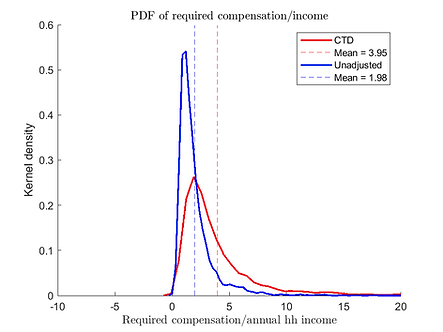
Research
Find examples of my work here. Please feel free to reach out with any comments, questions or suggestions.


A Dynamic Equilibrium Model of Commuting, Residential and Work Location Choices
With Christian Langholz Carstensen, Fedor Iskhakov, John Rust and Bertel Schjerning
We present a dynamic equilibrium model of joint residential and work location in which commuting costs depend on the distance between work and home, and house prices equate supply and demand for housing. We estimate the model using Danish register data for households in Greater Copenhagen area. We then predict the effects of increasing supply of residential housing on house rental prices, job mobility, residential sorting, commuting and welfare. In the second counterfactual simulation we show differential impact of telecommuting which implies substantial welfare gains and increased labor supply on the margin by educated workers whereas low educated workers benefit only slightly from lower housing prices in urban areas caused by out migration.
This research has been applied to simulate the effects of new housing construction on Lynetteholm, as part of a project for the Danish Ministry of Transport. The full report is available here:
Connect-The-Dots: Identification of Heterogeneous MWTP Functions under Time-Varying Preferences
Models based on residential location choice are widely used in non-market valuation.
This paper extends the work by Bishop and Timmins (2018), who show how repeat-purchase data can be used to recover preferences with individual heterogeneity. However, their method is unable to deal well with time-varying individual attributes that might prompt residential moves. I expand the approach to accommodate any number of observed time-varying individual attributes and apply the method to Danish register data to estimate the value of non-marginal increases in public transit time. I find that ignoring time-varying preferences underestimates average welfare costs by over 50%.
.png)



A dynamic life-cycle model of educational and occupational choices
With Christian Langholz Carstensen
This paper develops and estimates a dynamic discrete choice model of human capital investment that captures the full structure of the Danish post-compulsory education system, including both academic and vocational tracks. Individuals choose among study programs, work sectors, or unemployment, while anticipating the long-term career consequences of their choices. Using rich Danish register data, we estimate the model and apply it to assess two education policy reforms motivated by declining vocational enrollment and concerns about future skill shortages.
First, we simulate a policy that raises grade requirements for high school admission. This redirects students toward vocational education and unskilled work, leading to a short-run increase in average income. Over time, however, the policy results in lower academic skill accumulation, higher shares of unskilled individuals, and ultimately a decline in long-run income and welfare due to constrained educational choices.
Second, we evaluate the introduction of a combined vocational-academic program (EPX). The reform substantially raises vocational school enrollment while also encouraging continued study at the tertiary level, albeit with slightly delayed university entry. The more attractive choice set improves long-run welfare, raises average skill levels, and increases the tax base as students accumulate labor market experience and transition into higher-paying jobs.
A Model of Couples’ Joint Home and Work Decisions and the Intra-Household Allocation of Commuting
When studying individuals' choices of residence, workplace, and commuting patterns, it is crucial to account for the co-location trade-offs faced by dual-earner households, who often live together but work in different places. Much of the existing literature treats households as single decision-makers, overlooking the joint nature of these choices. Using high-quality Danish administrative data, I link household members and provide descriptive evidence showing that the way couples split commuting distances varies systematically across regions.
In particular, I explore how intra-household differences in commute distances between men and women relate to the gender wage gap, which also shows substantial spatial variation. To model this joint decision-making process, I combine the dynamic residential and workplace choice literature with insights from collective household models, developing a collective dynamic discrete choice framework that explicitly captures intra-household bargaining over location decisions.

